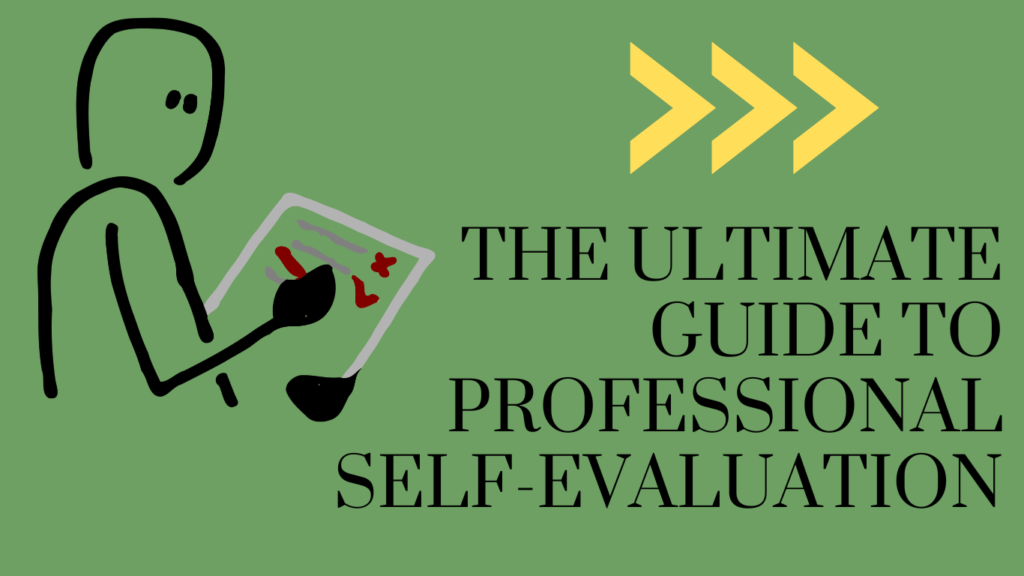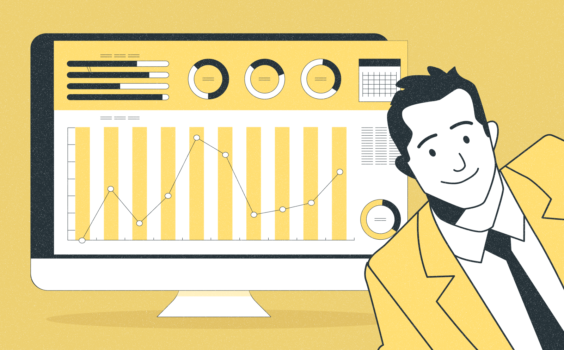How to Self Evaluate Yourself as a Professional

Self-evaluation is an important part of professional development. It allows you to reflect on your strengths and weaknesses, and identify areas in which you need to improve. In this guide, we will discuss the different types of self-evaluation, as well as how to write a performance evaluation self-assessment.
So whether you’re looking to improve your skillset or just want to get a better understanding of your strengths and weaknesses, this guide is for you! Keep reading.

When it comes to improving ourselves, can be a bit challenging. Sometimes it’s hard to see our flaws! That’s why professional self-evaluation can be so helpful. Self-evaluation allows you to take a step back and analyze your work performance objectively.
Professional self-evaluation is the process of assessing our work performance to identify areas in which we need to improve
This can be done through a variety of methods, such as reflection, feedback from others, or even quantitative data. No matter what method you choose, the goal of professional self-evaluation is always the same: to gain a better understanding of your strengths and weaknesses, so that you can work on improving in areas where you’re lacking.
How Do Organizations Benefit from Professional Self-Evaluations?
Organizations can benefit from professional self-evaluations in a number of ways. For one, it can help to identify training and development needs for employees. If you know that your team is struggling with a particular skill, you can provide targeted training to help them improve.
For example, Google uses self-assessment during its performance review, usually done at end of the first semester, and a complete review done between October and November. As the company is more interested in the how and why behind the results attained by employees during their self-assessment process, managers encourage employees to assess themselves on the following four main criteria:

An employee is expected to evaluate their skills against the above-listed criteria, with an emphasis on completed projects as evidence of their abilities
Why does Google use this approach?
Google draws a line between monetary benefit and personal development. The search engine believes that if an employee is focused on the money, they’ll be less likely to look at the big picture and work on their development.
Instead, Google wants its employees to focus on their development and how they can improve their skills. This way, they’re more likely to stay with the company for the long haul and contribute to its growth. You can read more about GRAD, the new method Google is using to conduct performance reviews here.
In addition to identifying training and development needs, professional self-evaluations can also help to improve communication between employees and their managers. Additionally, professional self-evaluations can also help to improve communication between employees and managers.
Including professional self-evaluations as part of your performance review process is a great way to encourage employees to reflect on their work and identify areas in which they need to continue developing. Not only does this benefit the employees, but it also benefits the organization as a whole by helping to create a more skilled AND engaged workforce.
No assessment is the same and companies don’t conduct the same methods over and over, let’s review which one serves best for you!
Get more out of your business
Get the best employee engagement content every week via mailing list
Types of Self-Evaluation Methods
There are many different ways to go about conducting a professional self-evaluation. Some common methods include reflection, feedback from others, and quantitative data. Let’s take a closer look at each of these methods!
Reflection
As a professional, self-evaluation is a crucial component of personal and professional growth. And while there are various methods of self-evaluation, reflection is perhaps one of the most effective. Through reflection, we can not only assess our progress toward goals and evaluate the success of our actions, but we can also identify new areas for growth and improvement.
Reflection is “the process of thinking carefully about something, especially to make a decision.”
In the context of self-evaluation, reflection is looking inward, considering our thoughts and feelings, and critically examining our behavior over some time. This can be done in written form, through journaling or creating a “learning log,” or verbally, through discussion with a coach, mentor, or friend.
Reflection can also be done informally, simply by taking some time to think about our experiences and what we’ve learned from them. Reflection allows us to reflect on the impact of our actions not just on ourselves, but on those around us as well. It helps us to pause and consider how our actions and decisions may have affected others.
TIP: A good way to reflect on your professional self is to keep a journal. This can be either digital or paper-based. Possible journal prompts could include:
- What went well this week/month?
- What didn’t go well this week/month?
- What challenges did I face this week/month?
- What did I learn this week/month?
- Who was helpful to me this week/month?
- What could I have done better this week/month?
Peer Feedback
Peer feedback is often overlooked as a valuable tool for self-evaluation in the professional world. By soliciting feedback from colleagues, managers, and peers, we can gain valuable insight into our strengths and weaknesses that may not be evident from our perspective.
This type of feedback also offers a fresh perspective on our actions and behavior in the workplace, providing new ideas for improvement and growth
Peer feedback can serve as a complement to other forms of self-evaluation such as self-reflection or 360 reviews. Incorporating peer feedback into your evaluation process can help to strengthen your relationships with coworkers and enhance job performance.
360-Degree Feedback
360-degree feedback is one of the most comprehensive forms of self-evaluation in the professional world. This method provides a 360-degree view of an employee’s performance by gathering feedback from colleagues, managers, and even clients or customers.

This diverse range of perspectives allows for more accurate assessment and unique insights into an individual’s strengths and weaknesses. Moreover, 360-degree feedback includes not only traditional assessments but also opportunities for open-ended comments, allowing for both tangible metrics and subjective observations to be considered in the evaluation process.
While this method may require a bit more time and effort than other self-evaluation approaches, its thoroughness makes it well worth it for those seeking a comprehensive understanding of their professional ability.
Quantitative Data
Quantitative data can provide an effective method of self-evaluation in a professional setting. By tracking numbers such as sales figures, profit margins, and project completion rates, individuals can assess their progress and identify areas for improvement.
Quantitative data can also be used to set specific goals and measure progress toward reaching them. In addition, this type of data allows for objective comparison with the performance of colleagues or competitors in the same field.
Quantitative data should not be the only method of self-evaluation, but it can provide valuable insights and inform important business decisions
Quantitative data should not be the only method of self-evaluation, but it can provide valuable insights and inform important business decisions. Overall, taking a data-driven approach to self-evaluation can lead to improved individual performance and success in a professional setting.
How to Write a Performance Evaluation Self-Assessment
Now that we’ve gone over the different types of self-evaluations, let’s discuss how to write a performance evaluation self-assessment. One of the most important things to keep in mind when conducting a professional self-evaluation is, to be honest with yourself.
Be as objective as possible in your assessment, and don’t be afraid to admit where you need to improve
It’s easy to focus on our positive attributes and downplay our negative ones, but this will only hinder your development in the long run.
Choose Your Method(s)
Then, it’s time to choose the method or methods that you will use to assess your work performance. As we mentioned above, the methods of reflection, getting feedback from others, and quantitative data are great options for you. Once you’ve decided on the method or methods that you’ll use, it’s time to start writing!
When writing your performance evaluation self-assessment, there are a few key points to keep in mind. First, be sure to focus on your work performance, rather than personal traits. For example:
- First, rather than saying “I’m a good team player,” try “I effectively communicated with my team members to complete the project on time.”
- Second, be specific and provide examples when possible. This will help your supervisor or manager to better understand your self-evaluation.
- Finally, don’t forget to mention both your strengths and areas for improvement. By doing so, you can create a well-rounded picture of your work performance.
Be Specific and Provide Examples
When completing a professional self-evaluation, it is important to be specific and provide examples. Simply stating that you have met or exceeded expectations without providing any evidence will not be enough for your supervisor to properly assess your performance.
When discussing your accomplishments, be sure to include specific tasks that you completed and the results of your efforts. For instance, instead of stating that you improved team morale, you could mention organizing a team bonding event and citing an increase in employee satisfaction survey scores.
Providing specific examples allows your supervisor to better understand the impact of your actions and make an accurate assessment of your performance
Additionally, be sure to include relevant challenges that you faced and how you overcame them. By being specific and providing concrete examples, you can effectively highlight the successes and challenges of your performance during the evaluation period.
Don’t Forget to Include Personal Metrics
Numbers sometimes speak for themselves. If you have access to performance data or other quantitative metrics, be sure to include them in your professional self-evaluation.
This type of data can help paint a more complete picture of your work performance and allow for objective comparisons
For example, if you increased sales by 10% during the evaluation period, be sure to mention this in your self-evaluation. Or, if you completed a project under budget and ahead of schedule, include these details as well.
Scope of Improvement since the Last Self-Evaluation
When writing your professional self-evaluation, it is important to address specific skills or areas that have improved. For example, perhaps a project management certification was obtained or communication techniques were refined.
It is also important to note any challenges or setbacks that have been encountered and steps that have been taken to overcome them. This demonstrates a willingness to learn and progress in one’s career.
Overall, writing about the scope of improvement since the last self-evaluation can showcase progress while also highlighting opportunities for continued development.
Set Up a Professional Development Plan
When writing a performance evaluation self-assessment, it is important to set up a professional development plan. This plan should outline specific goals and action steps for improvement in areas that may not be strengths, as well as strategies for maintaining and excelling in areas of strength.
Look at the example below!

This plan should also include ways to seek out additional training or education to stay current with industry trends and developments. By actively striving for personal and professional growth, employees can continuously improve their performance and skillset, ultimately benefiting both themselves and their employer.
Setting up a professional development plan when writing a performance evaluation self-assessment can ensure continued growth and success in the workplace.
Conclusion
We often dread that upcoming self-evaluation; however, take it as another step on the ladder to fulfill your career goals. No matter how you feel about self-evaluations, remember that this is your opportunity to showcase all of your successes and hard work from the past year.
By being specific and providing concrete examples, you can effectively highlight the successes and challenges of your performance during the evaluation period. Writing a professional self-evaluation doesn’t have to be daunting – use these tips to make the most of this opportunity and showcase your successes!
If you enjoyed our article, we invite you to keep reading our blog!
-The Monitask Team


